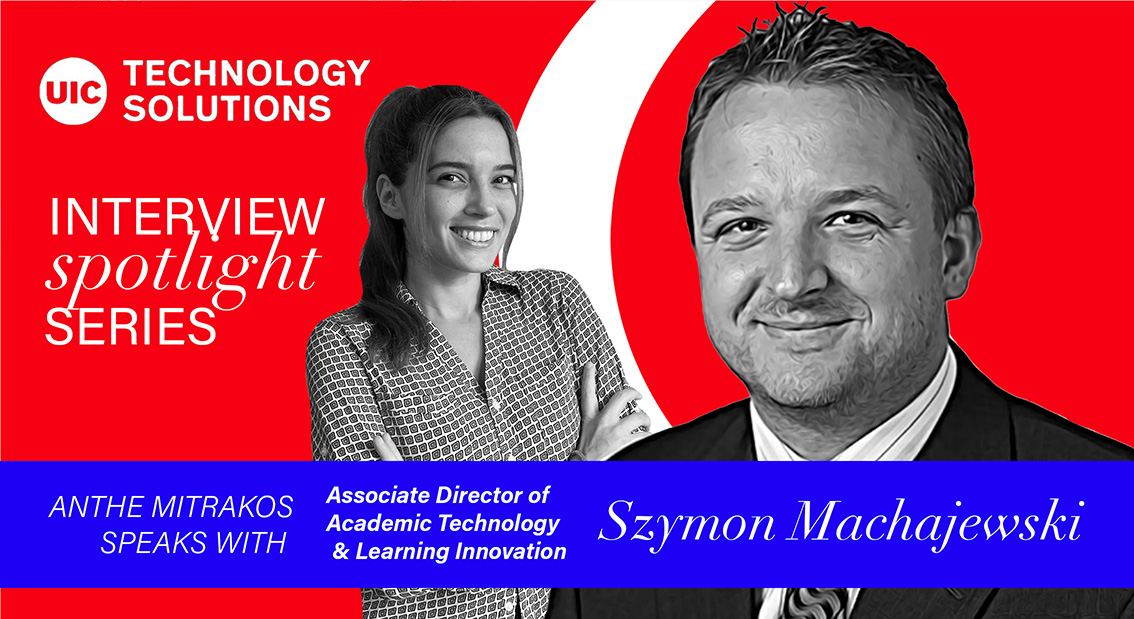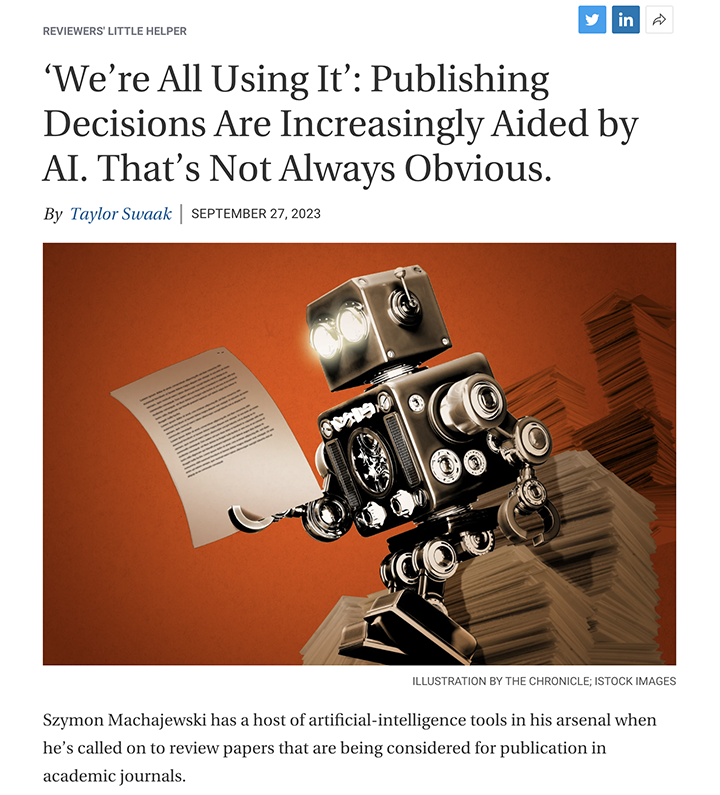The Role of AI in Higher Education: Interview with Dr. Szymon Machajewski, UIC Associate Director, Academic Technology & Learning Innovation

Introduction
The most impactful role that AI can play in educational environments is that of a personal tutor, says UIC Associate Director, Academic Technology & Learning Innovation, Dr. Szymon Machajewski in an interview with Technology Solutions' Anthe Mitrakos. In the 1980s Benjamin Bloom, known in Higher Education for Taxonomy that leads to better design of objectives and assessment, published a paper “Two Sigma Problem." In this paper, he showed evidence that one-on-one tutoring sessions can raise grades by two letter grades, Machajewski says. In this spotlight series, we ask Szymon about the future of AI in Highter Ed and at UIC.
Q1
Generative AI was recently discovered by the public. It has the potential to revolutionize how people create text content, music, images, videos, and more. This breakthrough in technology has significant implications for copyright as it enables the creation of original works.
| Associate Director, Academic Technology & Learning Innovation
Spotlight Interview with Dr. Szymon Machajewski

Anthe Mitrakos: What role should AI play in higher education and in your area of work?
Szymon Machajewski: AI can be explained as a super-smart assistant or tutor that can understand complex information and translate it into easy-to-understand language for anyone, including children. Let’s use a few examples to make it clearer. If you want to know about space, you could ask the AI, “Explain space like I’m 5.” It would then provide you with a simple and fun explanation suitable for a five-year-old.
If you’re curious about dinosaurs, you can ask for a picture of your favorite dinosaur, and the AI would create a lifelike illustration for you. For history lessons, you could request a video that brings the past to life, and the AI would generate one for you. In higher education, AI chatbots have emerged as powerful tools for both undergraduate and graduate students, offering unique opportunities to enhance the learning experience.
For undergraduates, AI chatbots can play a crucial role in helping students fill in knowledge gaps, learn new material, and practice what they know, all in a 24/7 mode. Unlike human tutors, these chatbots are not judgmental, creating a safe and non-intimidating environment for students to seek help and clarify doubts. This accessibility and lack of judgment can boost students’ confidence and encourage them to engage actively with the learning process.
Moreover, AI chatbots can cater to a large number of students simultaneously, making them highly scalable and efficient for undergraduate education. In the case of graduate education, the role of AI chatbots as tutors evolves beyond remedial support. Graduate students are often dealing with complex and specialized topics, where long-forgotten basics may be crucial to understanding advanced concepts.
Here, AI chatbots can serve as excellent reminders, helping students refresh their foundational knowledge and ensuring they have a solid grasp of the fundamentals before diving into more advanced studies. Furthermore, these chatbots can be valuable resources for brainstorming and inspiring new ideas. As graduate students engage in research and innovative projects, they can interact with AI chatbots to explore and refine their ideas, gaining insights and alternative perspectives that may not have been readily available otherwise.
Q2
AI chatbots in both undergraduate and graduate education provide a unique advantage over human tutors – they are available around the clock. Students can access these chatbots at any time, whether it’s to clarify a concept during a late-night study session or to seek inspiration for their thesis at odd hours.
| Associate Director, Academic Technology & Learning Innovation
T3
This 24/7 accessibility fosters a continuous learning experience, allowing students to learn at their own pace and according to their individual schedules. It also caters to the needs of distance learners or international students in different time zones, ensuring that no student is left behind due to time constraints. Moreover, AI chatbots offer a personalized learning experience.
By analyzing individual students’ performance and learning patterns, these chatbots can tailor their responses and recommendations to suit each student’s unique needs. This adaptability ensures that students receive relevant and targeted assistance, whether they require a more in-depth explanation of a concept or advanced challenges to push their boundaries.
Q3
As the field of AI continues to advance, these chatbots are becoming increasingly sophisticated and capable of simulating human-like conversations. While they may not replace human interaction entirely, they complement traditional teaching and mentoring methods, providing an additional layer of support and engagement in higher education. Whether it’s helping undergraduates bridge knowledge gaps or inspiring graduate students to explore new frontiers of research, AI chatbots hold great promise as valuable tutors in the higher education.
| Associate Director, Academic Technology & Learning Innovation
AI in Higher Education

A.M.: What are your concerns or reservations about integrating AI into the classroom or higher education?
S.M.: Technology adoption in the classroom or in Higher Education, in general, has been very slow. Our classrooms are very similar to the Industrial Revolution classrooms. My fear is that engagement with students will continue to suffer while engagement created outside of classrooms will be irresistible. Even today, many students feel that reality is broken.
This is why they exit to digital worlds such as games. Engagement in games based on social interactions, personal fulfillment, and immersive feedback is so overpowering that some started to view games as an addictive substance. An NPC in games (non-player character) driven by AI will be more engaging than most professors. Students will have interesting conversations with NPCs and, possibly, learn from them more than in the classroom.
A.M.: How do you think AI can contribute to personalized learning in higher education? Are there any specific areas or subjects where you see AI having the greatest impact?
S.M.: Artificial Intelligence (AI) has shown immense potential in transforming education, especially in assisting students with disabilities. One way AI can help is through the auto-generation of image descriptions and alt-text. This feature enables visually impaired students to access visual content and understand the context of images in educational materials. By describing images accurately, AI ensures an inclusive learning environment for all students, regardless of their visual abilities.
Another beneficial application of AI for students with disabilities is the ability to ask questions about images and long documents. Being able to conduct a conversation about instructional content will enhance understanding and fill in gaps in learning. AI-powered tools can analyze complex images and documents, providing detailed explanations and answering queries in real-time. This feature is particularly valuable for students with cognitive disabilities who may require additional support in comprehending challenging visual or textual content.
AI technology enables the development of interactive and accessible learning materials that cater to students with diverse needs and disabilities. These materials can be designed to work seamlessly with assistive devices such as screen readers, speech-to-text software, and alternative input methods. By ensuring accessibility for all students, AI promotes equal participation in the learning process and removes barriers to educational content.
T6

A.M.: How do you believe AI can contribute to research and innovation in higher education? Are there any particular fields or disciplines where AI has the potential to make significant advancements?
S.M.: The focus of ChatGPT conversation in academia has been overwhelmingly on undergraduate education in the context of academic integrity. however, the biggest advantages and opportunities reside in graduate education and publishing research. The simple reason for this is that experienced students and academic professionals are in a better position to critically evaluate the output from AI.
This means that their productivity can be improved as they ensure the accuracy of the content. Whether automating literature review drafts, or helping to design experiments, or ensuring the readability of article drafts, researchers who adopt AI will be more productive than those applying traditional methods. Let’s not forget the journal article “Why Most Published Research Findings Are False” by J. Ioannidis. The system of academic writing and publishing is deeply flawed.
A.M.: Looking ahead, what are your hopes and concerns for the future of AI in higher education? What would you like to see in terms of its development and implementation?
S.M.: We are witnessing a hype around AI caused by the free release of ChatGPT. In the 1970s a hype around AI led to “AI winter”. This was a period of time when investment and interest in AI was reduced. If the expectations for AI are not brought to realistic measure today, we may also face a cooling period. Traditionally, Higher Education is immune to innovation and technological progress. Even the Internet didn’t cause academic organizations to change in a significant way as classroom teaching and lecture approach remain the major methods of instruction.
Academics often stigmatize online learning and are slow to adopt it. This is because maintaining the status quo works for successful social classes and traditional businesses. There is little in terms of motivation for professors to innovate teaching methods. In fact, professors are often rewarded for their research and not teaching. Taking risks with innovations in teaching produces more exposure and unnecessary anxiety. This may be why the immediate response from the educational community to ChatGPT was to block it or view its use as a lack of academic integrity. Academic assessment is largely focused on writing, which means that it would be directly affected in the automation of this skill.
However, not all people have the ability to excel at writing and dyslexia held back generations from academic achievement. My fear is that academic environments will continue to be immune for an extended period of time to adopt AI and innovate their activities. Without significant competition, teaching can cost on old paradigms. In countries like the US, teaching as a profession is generally viewed with little respect and few opportunities. This is why we are likely to see innovation and productivity improvements in the commercial space where competitive advantage is valued and rewarded. Once industries adopt AI, some academic fields may also follow suit.
Dr. Szymon Machajewski featured in Chronicle of Higher Education

Szymon Machajewski was recently interviewed for a feature titled ‘We’re All Using It’: Publishing Decisions Are Increasingly Aided by AI. That’s Not Always Obvious,” in the Washington D.C.-based Chronicle of Higher Education.
Read the story here.
He has also contributed to, and been featured in several publications, including:
- 2023 EDUCAUSE Horizon Action Plan: Generative AI
- Blackboard Ultra User Group – AI Design Assistant
- Generative AI and Its Future @ UIC
- Envisioning How Data-Informed Colleges and Universities Will Redefine the Student Experience
- Harnessing the Power of AI in Education
- Anthology Uses Azure OpenAI Service to Empower Instructors
- Advancing Opportunities for AI in Higher Education